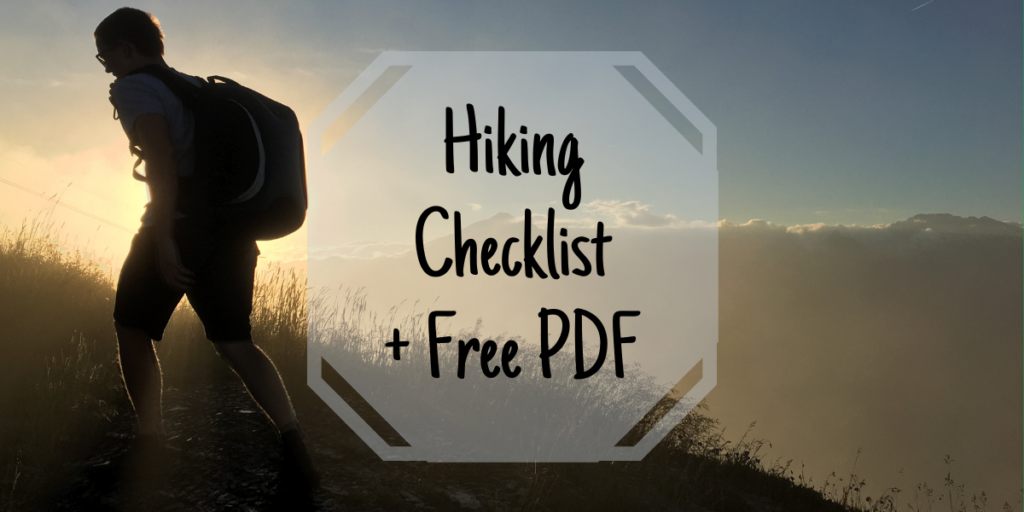Packing for a hike doesn’t need to be daunting. In fact, once you have the basics down, it’s super easy! I always start with the 10 essentials, then food/snacks/water, then anything extra. Use this hiking checklist to help guide you through the planning and packing process. Don’t forget to download your free hiking checklist PDF!

What to Bring On a Hike
10 Essentials for Hiking Checklist
Map and compass. Even if you use an electronic GPS, you’ll want to have a map and compass with you. Electronics malfunction, break, get water damaged or lost and it’s always good to have a backup navigation plan in the form of physical maps. Tip- If your map isn’t waterproof, put it in a ziplock bag!
Light. Bring a flashlight or a headlamp. Bringing an extra set of batteries is a smart move too
Sun protection. Sunblock and sunglasses and a hat are my go to. UV blocking clothing is nice as well.
First aid kit. You can buy a commercial kit, or create your own. I find the commercially available kits to be bulky and contain lots of unnecessary stuff. You can build your own from scratch, or tailor a premade kit to fit your needs.
Knife/Multi tool and repair kit. Boot sole suddenly separate from your boot? Repair kit to the rescue. Some duct tape, paracord, safety pins, a small sewing kit with needles can help fix many situations that arise on trail.
Fire kit. Storm proof matches or a fire starter and lighter. My favorite fire starters are cotton balls dipped in Vaseline, stored in an old medicine bottle.
Emergency shelter. A tarp, bivvy, or even an emergency blanket can all be used as an emergency shelter. Use the paracord from your repair kit to set your tarp/blanket.
An extra days worth of food and water. Should something happen while you’re hiking and you’re out longer than expected, having the extra nutrition and water can go a long way in keeping your morale and energy up. If you don’t want to pack extra water, you at least should know that there is a reliable water source near trail and how to access it.
An extra layer. Temps can drop low when the sun goes down. Have an extra, warm layer in your pack always. A jacket, hat, even a pair of gloves can help you ward of hypothermia if you have to unexpectedly stay overnight.
What to Wear Hiking
You don’t need special or expensive clothing to go hiking, you may even already have what you need. Following some basic guidelines when choosing your hiking attire will have you comfortably and appropriately dressed with spending a fortune.
Clothing Material Choices
No Cotton. Cotton holds onto moisture and can cause chafing and irritation. The moisture it holds onto can contribute to hypothermia when and if the temperature drops.
Merino Wool. Even though it sounds warm, merino is good for all seasons. It’s moisture wicking capabilities are wonderful, keeping you dry and comfortable. You can find merino clothing on Amazon or at most outdoor stores, such as REI or Moosejaw
Polyester or Nylon. Chances are you have some polyester or nylon clothing already. These work well for base layers and other layers alike. They’re moisture wicking and they dry quickly. Many athletic clothes are made with one of these materials, or a combination of them.
What to Wear
You’ll want to wear comfortable pants, but not denim. Hiking pants, leggings made from polyester or nylon, or any type of athletic pants are usually good options.
Any shirts or tops made of moisture wicking materials. Layer your tops so that you can easily peel layers off and add them back as necessary.
Make sure to have a warm layer and a rain shell in your pack, just in case.
How to Use This Hiking Checklist
This is a basic hiking checklist, created using the 10 essentials as a base. Since every hiker has different needs, I’ve left blanks where you can fill in your own items.
The first aid kit packing list can be customized to fit your personal needs. Use the blank lines to add in your own items. I have a post that details how to build a hiking first aid kit, it may be useful as you create yours. Don’t forget to add nay prescriptions or medications you’ll need to take during your hike!
Related Content
Hiking for Beginners- Everything you need to know
What Gear is Needed for Backpacking
How to Build a Hiker’s First Aid Kit
